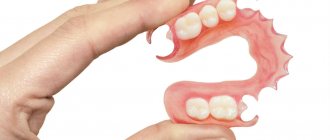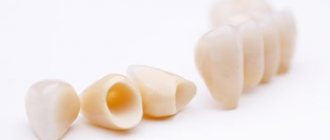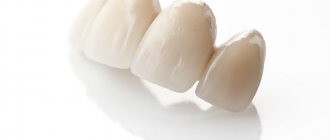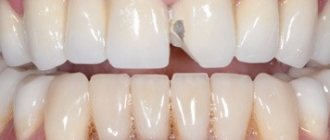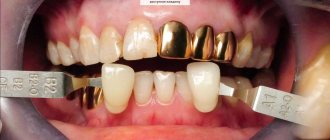Installation of crowns is a type of dental restoration. Crowns are installed if the tooth:
- Significantly destroyed by caries (by a third or more);
- As a result of mechanical impact, he was damaged;
- Has an unattractive appearance (stains on the enamel, yellowness or darkening).
These designs:
- Cover the entire tooth;
- Restore functionality;
- Maximum corresponds to the characteristics of the bite;
- Recreate the anatomical shape;
- Have an appearance that matches a natural tooth;
- Provide the dental unit with highly aesthetic qualities;
- Significantly extends the life of the tooth.
Negative points:
- High price;
- The need for tooth filing;
- Long manufacturing period (in a dental laboratory, using individual impressions).
Metal crowns
This type of crown has been used for a long time. They are reliable, but not aesthetically pleasing. They are made of steel, using titanium coating or gold. Metal crowns can cause a pathological reaction if there is intolerance to metal inclusions in the oral cavity.
The pathological effects of metal inclusions can be of three types:
- Electrogalvanic – formation of galvanic microcurrents;
- Toxic-chemical - galvanic currents destroy metal alloys, causing corrosion;
- Allergic – corrosion products can cause allergic reactions.
People who have metal crowns installed are more likely to experience the following unpleasant symptoms:
- Bleeding gums;
- Inflammatory diseases of the oral cavity;
- Blue gums;
- Formation of a dark stripe in the neck of the tooth.
There is an opinion that metal crowns cause the development of gastrointestinal diseases, including cancer, since metal ions and oxides corrode the walls of the gastrointestinal tract, promoting the formation of ulcers and intoxication of the body.
Gold crowns are more beneficial to the body, but are softer.
What is a crown and why are we considering metal?
A crown is a dental structure that is a miniature thin-walled cap that is placed on a dilapidated or implanted tooth. The purpose of a dental crown is the functional and aesthetic restoration of the dentition.
Metal crowns
on teeth are characterized by high strength and long service life. In addition, metal microprostheses have the following advantages:
- The restored tooth does not require special preparation.
- The ability of the crown to withstand heavy workloads.
- The chewing functions of the tooth return in full.
- Easy to manufacture and install the prosthesis.
- Democratic price.
Solid crowns are made from an alloy of cobalt and chromium, which gives them a shiny, dark surface. Considering the low aesthetics of the element (the gray shine of the metal), crowns on teeth made of metal alloys are often made with a white coating and installed in the rear areas of the jaw that are invisible to view.
Let's look at all the pros and cons of metal crowns, this will help you make the right choice when installing them.
Is it dangerous to wear crowns?
This is not to say that crowns are harmful. Another thing is that there are different materials for their manufacture. Modern crowns are made from completely bioinert materials that do not affect human health.
There are established opinions about the dangers of crowns. For example, the following.
- Teeth rot under crowns
Such cases do occur in dental practice, but the reason for this is:
- Poor oral hygiene. This is a common cause of tooth decay, regardless of the presence of crowns.
- Refusal to install a temporary crown when the patient has to walk with a ground tooth for some time.
- Orthopedic structures of low quality, poorly adjacent to the tooth surface. The gaps between the crown and the tooth are filled with plaque and lead to the development of inflammatory processes.
The condition of the tooth before the crown is placed is also important. There are cases when a crown is used to cover an almost destroyed tooth that needed to be removed.
Rotting is a rare occurrence and cannot serve as a reason to refuse treatment. By maintaining proper oral hygiene and choosing a dentist responsibly, the risk of tooth decay under the crown is minimal.
- When installing a crown, the tooth is heavily ground down
Modern dentistry is aimed at preserving dental tissue as much as possible, since the prognosis for restoration is significantly improved. Modern tools and equipment allow this manipulation to be performed as carefully as possible.
Strong preparation is not currently carried out.
- After the crown is removed, the tooth will have to be removed.
Service life and care rules
The service life of ceramic composite crowns is at least 10 years. The patient needs to carefully care for his dentures, visit the doctor regularly, brush his teeth in the morning and evening, and after eating, paying special attention to the interdental spaces. If there are chips or cracks in the composite enamel, you must promptly contact your doctor to have the prosthesis repaired. Repairability is the main advantage of ceramic composite crowns, which metal ceramics and even zirconium dioxide do not have. In case of chips and cracks, such crowns need to be completely replaced, but the ceramic composite can be easily restored right in the doctor’s chair and you will not need to spend money on a new crown.
Read detailed instructions on how to care for teeth with installed crowns >>>
A beautiful and snow-white smile for many years. Ceramic veneers and lumineers correct defects, do not stain and even protect teeth!
free consultation
Promotion for installation of crowns in Moscow
If the tooth is properly prepared for crown installation, further prosthetics can be performed. A tooth will have to be removed only if it was subject to removal before prosthetics.
- Depulpation must be carried out necessarily
Innovative dental technologies and high professionalism of the doctor make it possible to install crowns on living teeth.
Today it is even possible to cure pulpitis and caries without removing the denture.
Indications and contraindications
Coated metal dentures are installed to recreate the anatomical shape of chewing molars. Also indications for prosthetics are:
- Prevention of pathological tooth abrasion.
- Improved fixation of removable structures.
- Various damage to the crowns of teeth that cannot be restored.
- The absence of one or more units of the dentition.
- Replacement of previously installed prostheses.
- The presence of various defects.
Causes of pain under the crown
A tooth under a denture can hurt both due to unprofessional work of the dentist, and due to a piece of instrument getting into the canal.
In addition, metal structures are installed as supporting teeth when installing bridge structures.
Contraindications to the installation of sprayed dentures are:
- Presence of cancer .
- abnormalities .
- In case of defect of the entire dentition.
- disease .
- Periodontal disease and periodontitis, occurring in severe form.
- Increased wear of molars.
Also, metal structures with coating are not installed in the presence of osteoporosis or osteomyelitis of the jaw bone tissue.
Which is better – several fillings or one crown?
Fillings will be cheaper, but the effectiveness of the treatment will be at a loss. Large fillings cannot cope with high chewing loads; thin walls often break.
Crowns effectively strengthen the tooth, prolonging its use, including by evenly distributing the load, unlike fillings, which actually destroy them.
In any case, only a dentist can offer the best option for dental treatment, based on the results of the examination.
Author:
Mayorov Andrey Mikhailovich
Specialization:
orthopedic dentistry, dental prosthetics, implant installation
Characteristics
Metal alloys have earned the trust of dentists due to their biocompatibility and wear resistance. The basis of the model is also a metal frame lined with various materials: steel, gold, ceramics, titanium, cobalt chromium, silver alloy with palladium. These materials have one significant drawback - the lack of naturalness. The finished structure takes on the shade of the alloy from which it is made.
Devices coated with gold are especially durable. The flawless smooth surface of the structures helps to avoid the proliferation of pathogenic microbes and prevents the accumulation of food debris. Unfortunately, due to their high cost, they are not available to most patients.
Models coated with titanium nitride are distinguished by their high aesthetics. They are in greatest demand.
Externally, such crowns are the most natural. With their help, not only premolars are restored, but also canines and incisors. Sputtering is carried out using a vacuum-plasma technique.
A distinctive feature of metal crowns from other orthodontic structures is their durability. They can easily withstand significant loads while chewing food.
Metal crowns are produced using two methods: stamping or casting (based on an individual impression).
Transfer to a metal frame is carried out in several stages:
- Disinfection of the prosthesis.
- Polishing.
- Mixing titanium with other components occurs using high temperature and vacuum conditions.
Manufacturing method
Coated crowns are made in two ways: solid casting based on an anatomical cast, or stamping. When applying the coating, the prosthetic part is disinfected and polished, after which the facing layer is etched into the base due to exposure to high temperature.
The technology for creating stamped products involves the use of sleeve blanks processed in accordance with the prototype obtained when taking an impression of the dentition. Such models are distinguished by their affordable cost, durability and functionality, however, it is important to consider that the stump base, located under the “cap,” inevitably wears out under the influence of mechanical loads.
How to install sprayed crowns
Spray-coated metal dentures can be fixed to both the front and chewing teeth. If the smile area is to be restored, it is recommended to give preference to white products coated with zirconium. They look better than others against the background of their natural “neighbors.”
When working with molars, structures coated with other alloys can be used. This is explained by the fact that they are not noticeable to others, but at the same time they are reliable and durable.
The dental appliance installation process includes four basic steps:
- Preparatory activities.
- Preparation of a damaged natural crown.
- Taking impressions.
- Installation.
Each of them is very important and takes a lot of time.
Preparatory activities
First, the dentist carefully examines the patient’s oral cavity and talks with him. He finds out the client’s wishes and checks whether he has any contraindications to the use of metal prostheses.
Then he takes pictures, studies them and proceeds to depulpation - removal of the dental nerve and cleaning of the canals. This procedure is necessary to prevent pain from occurring in the treated tooth in the future. After all, then you will have to remove the crown, treat pulpitis and make a new dental prosthesis, and this is expensive and troublesome.
Stump formation or preparation
To give the remaining tooth the desired shape, it is processed in a certain way. At his discretion, the doctor can use the following preparation methods:
Air with abrasive. This method is suitable if you need to remove a small outer layer. A mixture of air and abrasive powder is applied to the tooth under high pressure. Eventually, the outer covering of the teeth is removed.- Laser. Innovative laser equipment is used, which carefully processes the tooth surface and removes its excess. In this case, the tooth does not heat up. Consequently, burns of soft tissues and mucous membranes are completely excluded. Chips do not appear on the molar.
- Ultrasound. Preparation using this method is also painless. The destroyed crown is carefully processed, giving it the required shape. The pulp does not overheat during operation.
The doctor always decides which method to prefer, based on the characteristics of the clinical situation.
Taking impressions
When the stump is prepared, the patient is invited to take impressions. This procedure is absolutely painless. The doctor applies a special gel to a special plate, then carefully places it on a row and asks the patient to bite down on the device.
Then he carefully removes the resulting impression and immediately transfers it to the dental laboratory. Based on it, an individual metal prosthesis with coating is made.
Installation
Before the crown is finally installed, the patient is invited to try on the manufactured system. If any discrepancies are found, the device is adjusted and re-fitted. Continue this way until a perfect fit is achieved.
Afterwards, the crown is sprayed and fixed with permanent cement. Immediately after the glue hardens, a person can use his new tooth as if it were his own. At first, the presence of an artificial unit in the mouth often causes unusual sensations, but they quickly pass.
Features of care
- Daily proper care of dentures is important: brushing teeth and interdental spaces, using rinses and dental floss.
- It is necessary to monitor the condition of your gums.
- You should visit your dentist periodically to help identify the development of gingivitis and periodontitis at an early stage. These diseases lead to crown detachment.
- If the integrity of the prosthesis is damaged, you must immediately contact the clinic for its restoration or replacement.
The one-piece construction sits tightly on the chewing element and hermetically envelops it. Therefore, the patient should not worry about the fact that pathogens or food particles can penetrate under it.
Good to know. Modern solid crowns are not afraid of solid food and are resistant to chemical and thermal irritants.
